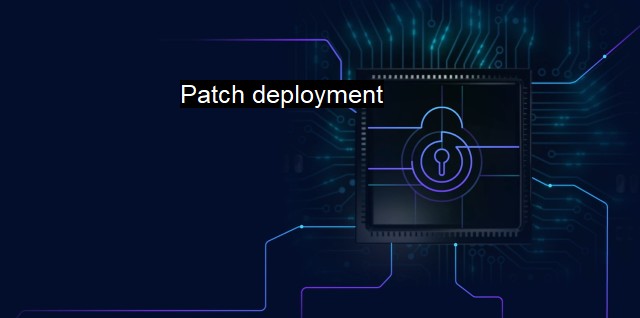What is Patch deployment?
Securing Your Operating System: Understanding the Importance and Process of Patch Deployment in Cybersecurity
Patch deployment refers to the process of distributing an update or fix known as a 'patch' to various computers or systems within a network. Patches are vital for maintaining the optimal function and security of a systems or software, and building resilience against potential security threats or vulnerabilities. In the realm of cybersecurity and antivirus applications, patch deployment represents a quintessential operation for ensuring that networks, systems, and individual devices have the most recent, updated line of defense against the deluge of cyber threats.In the world of computing, software products are continuously evolving entities. They are routinely updated and enhanced with new features, repairs for existing bugs, and layers of security against emerging threats. The updating process involves swapping out certain parts of the software code with newer, improved versions. This is where patches come into the equation. Usually, patches are widely distributed solutions to fix intentional or unintentional vulnerabilities that exist in the product's source code which, if left unsolved, may expose the system at risk of cyber-attacks.
Patch deployment, thus, ensures that these fixes are installed on every system that uses the software in question. This prevents minor bugs from escalating into serious configuration lapses and underlying security vulnerabilities from being harnessed by malicious attackers, consequently reinforcing the system against cyber threats.
Generally, patches are deployed automatically. They can either be pushed to all devices in a network by the network administrator or distributed via the software vendor’s update service. Some patches may require user's permission, thereby requiring the user to manually agree to the update. It is vital to have a controlled patch management process to protect against operational disruptions. It is also necessary to test patches before rolling them out universally, as some patches may have unidentified bugs or may not be compatible with their host software.
Right patch deployment is critical because many cyber threats exploit common, known software vulnerabilities that could be remedied by available patches. Malware such as worms, trojans and ransomware are known to capitalize on these vulnerabilities. By updating software either automatically or manually through distribution of patches, systems are far less likely to be infiltrated by such threats. In fact, one of the premier forms of ensuring system security is simply to maintain the latest patches.
Highlighting the area of antivirus software, patch deployment remains equally pivotal. The efficacy of antivirus software gets highly dependent on its acuity of latest threats. Therefore, antivirus software usually updates its database regularly. This essentially represents a form of patch deployment. On each update, patches carrying newly identified virus definitions are deployed onto the host system thus expanding the database the antivirus uses to detect and counter threats.
When working with patch deployment in the context of cybersecurity and antivirus applications, attention must be given not just to the automatic patches, but regular checks must be carried out to ensure no necessary updates are overlooked.
A well-designed and executed patch deployment strategy brings substantial gains in operational efficiency and cybersecurity preparedness. Negligence in patch deployment may lead to system insecurities, disruptions, and consequent business liabilities. Nonetheless, the rights tools, custom-made for resilience and adaptability such as systems management software, can help ensure patch deployment as a regular activity rather flowing as a strategic response to crisis.
To sum up, patch deployment forms an elemental part of every organization's cybersecurity infrastructure. It is the procedure of distributing and installing chunk of codes to a system or a software to fix existing bugs, amplify certain features and layer-up security. Exclusively in cybersecurity and antivirus domains, deploying recent patches is an endeavor that continuously fortifies users against potential threats and attacks. Having a consistent strategy for patch deployment ensures that the software keeps pacing with the ever-evolving world of cyber threats.

Patch deployment FAQs
What is patch deployment?
Patch deployment refers to the process of updating and fixing vulnerabilities in software and operating systems by deploying software patches. In cybersecurity, patch deployment is crucial as it helps in maintaining the security and protecting against potential cyber attacks.Why is patch deployment important in cybersecurity?
Patch deployment is important in cybersecurity because it helps in fixing vulnerabilities in software and operating systems. Cyber attackers often target vulnerabilities in software and systems to gain access to information or control over systems. Patch deployment ensures that software and operating systems are up to date and less vulnerable to cyber attacks.How often should patch deployment be done for antivirus software?
Patch deployment for antivirus software should be done as soon as updates become available. Antivirus software is continuously updated to detect and protect against new threats, and delays in patch deployment can leave systems vulnerable to attacks.What are the consequences of not doing patch deployment for antivirus software?
Not doing patch deployment for antivirus software can result in systems being vulnerable to cyber attacks. Cyber attackers can exploit vulnerabilities to gain unauthorized access to systems, steal data, or cause damage. Additionally, not doing patch deployment can result in software and systems becoming outdated, which can cause performance issues and impact productivity.| | A | | | B | | | C | | | D | | | E | | | F | | | G | | | H | | | I | | | J | | | K | | | L | | | M | |
| | N | | | O | | | P | | | Q | | | R | | | S | | | T | | | U | | | V | | | W | | | X | | | Y | | | Z | |
| | 1 | | | 2 | | | 3 | | | 4 | | | 7 | | | 8 | | |||||||